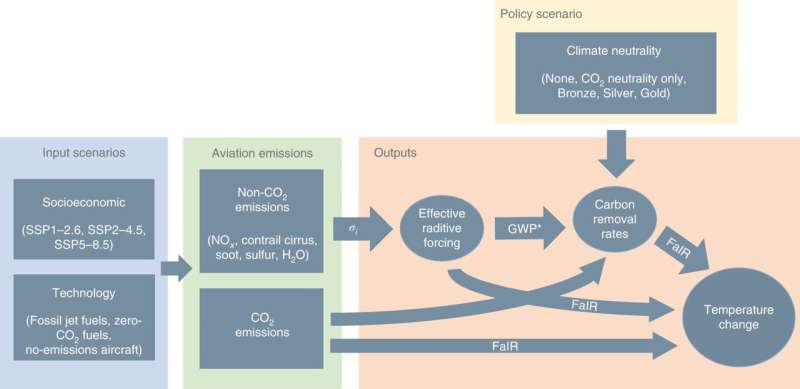

A trio of researchers, two with the Swiss Federal Institute of Technology’s Department of Environmental Systems and the other with Climate Service Center Germany, Helmholtz-Zentrum Hereon, say that reducing CO2 emissions from aircraft will not fully solve the problem of their negative climate contributions. In their paper published in the journal Nature Climate Change, Nicoletta Brazzola, Anthony Patt and Jan Wohland note that other emissions from aircraft also contribute to climate change.
As climate change progresses and governments around the world fail to enact measures to eliminate greenhouse gas emissions, scientists continue to look for ways to address the problem. In this new effort, the researchers are pointing out to both the science community and governmental officials that forcing aircraft makers to reduce or eliminate CO2 emissions from the planes will not eliminate their carbon footprint. In addition to CO2, the researchers note, jet airplanes have an indirect impact on the climate—they create contrail cirrus, which contain aerosols, soot and water vapor that incite changes in O3, CH4 and water levels in the stratosphere due to NOx emissions. Together, these emissions account for enough warming to heat the planet by an additional 0.4° C in the coming years.
The researchers note that emissions besides CO2 from aircraft are not currently being discussed as part of global warming mitigation efforts to reach the goals set by the Paris climate agreement—and failure to do so will likely perpetuate the negative indirect impact of aircraft on global warming. They suggest including plans for reducing or removing harmful elements from the contrails left behind by jet aircraft flying in the stratosphere.
The researchers also created a model to better illustrate their point that showed that failing to address the airline industry’s non- CO2 climate impact would preserve approximately 90% of the negative impact that airplanes have on climate change. They note also that scenarios that involve attempting to make air travel carbon neutral by planting forests would involve covering a piece of land the size of Germany with nothing but trees.
Review suggests current global efforts are insufficient to limit warming to 1.5°C
Nicoletta Brazzola et al, Definitions and implications of climate-neutral aviation, Nature Climate Change (2022). DOI: 10.1038/s41558-022-01404-7
© 2022 Science X Network
Citation:
Net-zero carbon emissions for aircraft overlooks non-CO2 climate impact (2022, July 26)
retrieved 26 July 2022
from https://phys.org/news/2022-07-net-zero-carbon-emissions-aircraft-overlooks.html
This document is subject to copyright. Apart from any fair dealing for the purpose of private study or research, no
part may be reproduced without the written permission. The content is provided for information purposes only.